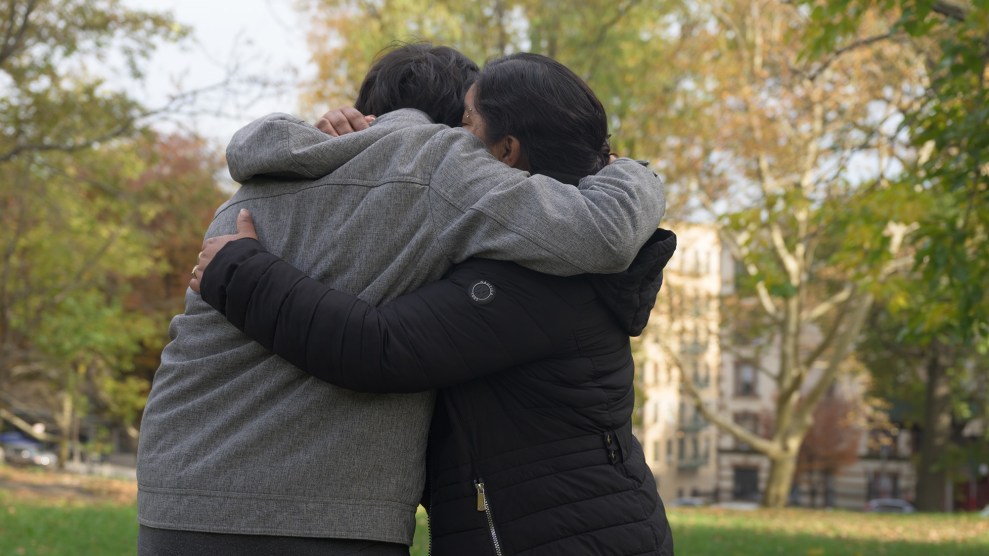The United States guarantees 7.2 million students with disabilities an equal education. But the system is broken. For this package, we spoke with students, parents, teachers, and advocates about the dire state of—and efforts to fix—programs for students with disabilities. You can read all the stories here.
In the early 2010s, after working as an elementary school teacher of students with disabilities in Kansas for a couple years, Kimberly Knackstedt was finally seeing her work pay off. She merged classes with a general education teacher’s for part of the day, meaning her students were spending more time with their neurotypical peers—an approach that has long been shown to benefit students. “It was so successful,” she says. “It was a fantastic model.”
She was also working closely with her students and their families to help them understand how to get the services guaranteed to them—resources such as extra time for tests, interpretation for those with hearing or vision disabilities, or physical therapy and psychological assistance.
But it didn’t take long for Knackstedt to run into roadblocks. With no downtime in the day to plan their co-teaching curriculum, Knackstedt and her colleague had to meet before school, unpaid, to keep the program going. When she requested days off to attend disability-specific training, she says, her school didn’t have enough money to send her—so she paid out of pocket and used her vacation days.
Despite studies showing that almost all students with disabilities are capable of graduating high school in four years if given the right resources, only about seven in 10 of the 7.2 million public school students receiving disability program support do graduate—far below the 86.5 percent rate for American students overall. “I couldn’t help my students reach the outcomes and the things they wanted to achieve,” says Knackstedt, who left the classroom nearly a decade ago to work in education policy and disability advocacy. “I didn’t feel, as one person, as one young teacher, that I could actually make a difference.”
How did we end up with a system that teachers, students, parents, and state and federal governments have declared to be broken? Teachers have long made improvements for students with disabilities a linchpin of their unions’ collective bargaining demands. Parents of children with conditions ranging from dyslexia to autism to hearing disabilities have filed huge numbers of complaints with the federal Department of Education’s Office for Civil Rights, alleging everything from insufficient services to excessive force and problems with service animals. Those complaints have led to more than 2,500 currently open investigations—some of which have been unresolved for over a decade.
The pandemic only worsened the situation: Students with disabilities lost more ground on test scores and graduation rates than general-education students. Ever since, notoriously low-paying positions for teachers of students with disabilities have been especially hard to fill, leaving in a lurch the nearly one in six students who qualify for such services. This year, the DOE declared that more than half of the states are failing to meet federal Special Education program requirements.
At the root of this overall failure is a lack of funding from the federal government: Teachers’ calls for greater resources repeatedly go unheeded, while parents are left to grapple with denied services. States and school districts have been found to mistreat students and misuse funds. And from New York to Washington state, lax laws have allowed public dollars to flow to private companies that turn a large profit while failing and even abusing students.
“We know there are funding shortfalls,” says Knackstedt, who, after serving as the White House’s first-ever director of disability policy from 2021 to 2022, is now the director of the Disability Economic Justice Collaborative at the nonprofit think tank Century Foundation. “We know that students and parents don’t always have access to their rights.” These shortcomings, combined with deep economic and racial inequities, says Knackstedt, mean that students with disabilities don’t have the same access to educational opportunities as general-education students. And that isn’t just an injustice—it’s a violation of federal law.
A pledge unfulfilled
Less than 100 years ago, disabled children “were fundamentally not allowed in school,” says Knackstedt. They were forced to stay home or enter grisly state institutions. Some students with “mild” disabilities were thrust into classrooms, but without support, many dropped out. A lot of students with disabilities were completely—and legally—shut out of the classroom.
That changed in 1975, when President Gerald Ford signed landmark legislation that would come to be known as the Individuals With Disabilities Education Act. IDEA declared that every disabled child was entitled to a “free appropriate public education.” Each disabled student would receive a tailor-made learning plan called an Individualized Education Program (IEP), detailing and guaranteeing the services needed for each student to succeed. Crucially, the federal government promised to cover 40 percent of the average per-pupil cost, increasing budget benchmarks until that target was hit. But officials later revised the language to say they would pay a “maximum” of 40 percent, and quickly stopped hitting those escalating benchmarks. In the nearly 50 years since IDEA was passed, the federal government has never ponied up the 40 percent it authorized. Today, it foots less than 13 percent of the bill.
With no requirement that education programs be “fully funded,” states and districts are left to decide if and how to make up the difference. But according to education funding researcher Tammy Kolbe, only one state, Wyoming, fully funds education for students with disabilities. As a result, localities in other states end up having to pick up the financial slack as much as they can. However, Kolbe says, we don’t actually know how much money states and districts pay toward disability services in education because IDEA reporting requirements lump all spending together—whether from federal, state, or local sources. That reporting also doesn’t paint a clear picture of exactly what those public dollars are spent on. The last time we got a comprehensive look at what we fund and how was in 1999, Kolbe says, when the federal government commissioned a major study on it.
Early findings from a study by Kolbe and her colleagues suggest that states and districts with fewer resources “are less likely to identify students for special education”; this underidentification, they posit, might be the result of such places rationing services due to lack of resources. That leaves some students who need accommodations like interpretation and reading assistance without the aid they are legally entitled to. Starting in 2016, a flurry of high-profile investigations spotlighted the failures of states and districts: First, a Houston Chronicle investigation revealed that the Texas Education Agency had placed an illegal cap on the percentage of students it would permit to receive services, secretly allowing only 8.5 percent of students to receive IEPs and corresponding services, and refusing aid to other students who applied. That case spurned a federal investigation, and, Knackstedt says, set off alarms in the education world by ”[making] everyone a little bit more aware that there were probably bigger issues within every state.” Sure enough, other states and districts were revealed to be making it prohibitively difficult for students to get support. And in 2020, four years after the first Texas bombshell, a follow-up federal investigation into Texas’ programs revealed that some students with dyslexia—the most common learning disability—were falsely told their disability didn’t qualify them for services.
Inequities are baked in
The money problem is actually twofold: It isn’t just that there’s not enough of it, it’s also that the money’s not going where it is needed most. In a recent study, Kolbe and fellow researchers Elizabeth Dhuey and Sara Menlove Doutre proved that even the small amount of federal funding for disabled students that is released annually is disbursed in a wildly inequitable manner.
IDEA’s funding formula, which is based on population data, hasn’t been updated since the late 1990s. But population figures have changed since then, meaning that states with growing populations—or more low-income students, or higher numbers of students of color—methodically receive less funding per disabled pupil than states with smaller, whiter populations: Wyoming’s share of federal funding covered 23 percent of the average price tag per disabled pupil in 2020. On the other hand, Nevada, which has more low-income students and students of color, had only 11 percent of that bill covered by the federal funds. “What we find,” says Kolbe, “is systematic evidence that…the dollars don’t go to where they’re most needed.”
Financial inequities aren’t baked into just the current funding formula; they’re also baked into the law itself. When IDEA was passed, it placed a large responsibility on parents, leaving them to challenge or even sue the school district if the parents felt their children’s IEPs were inadequate or not being followed. But such mediation is a time-consuming and sometimes costly process—and families without such resources find themselves without recourse. Lawsuits—a last resort available almost exclusively after all of IDEA’s “due process” options are exhausted—can be even more taxing. And even parents with the resources to challenge their children’s IEPs have come up against education systems that rarely rule in the parents’ favor: Last year, a Virginia class action lawsuit brought by parents of a child with disabilities and their nonprofit advocacy group Hear Our Voices revealed that, over the last two decades, the state’s Special Education hearing officers sided with parents in less than 2 percent of cases.
Dollar signs in disability
Some money-hungry corporations see dollar signs in disability, exploiting loopholes that allow public money earmarked for Special Education programs to flow to private, for-profit entities, and profiting off of exorbitantly expensive, inadequate, unnecessary, or, in some cases, abusive services. Last year, a New York Times investigation revealed that private companies in New York—including startups with little education experience—received a “windfall of government money for services that are sometimes not needed, or even provided.” Some providers billed $200 an hour for tutoring services—five times higher than the government’s typical rate. The parents requesting these outside services, the report found, were sometimes prodded directly by the schools—which had occasionally accepted donations from those very providers.
ProPublica and the Seattle Times also published an investigation last year into the private corporation Universal Health Services—a billion-dollar psychiatric hospital chain that got into the school business in 2005, and eventually opened the largest publicly funded private school chain for students with disabilities in Washington state. At the schools—which took in a minimum of 38 million in taxpayer dollars over a five-year period—trained teachers were few and far between; information about academic progress was kept from parents; employees frequently punished kids by secluding them from their peers; and complaints of abuse were rampant. Two of the schools have since closed, and Washington state recently banned the school from accepting new students due to the school’s “unacceptably high” use of restraint and isolation.
Teachers have repeatedly spoken out against the often costly and sometimes exploitative involvement of the private sector. But the public sphere is not immune to excessive and inappropriate discipline for students. Just this year the Justice Department found a school district in Alaska had “repeatedly and inappropriately” isolated students, including in “purpose-built isolation rooms that lock from the outside.” Some students, the Justice Department said, resorted to self-harm during their isolation.
Where do we stand now?
When parents and advocates of disabled students in Virginia filed the class action lawsuit last year against the state’s DOE and Fairfax County School Board for violations of the rights of students under IDEA, the parents thought they had a slam dunk on their hands. Local and national media covered the suit extensively, with some seizing on the mind-bogglingly low 2 percent rate at which the state’s IEP hearing officers sided with parents. Plus, the lawsuit came on the heels of years of Fairfax County investigations, which found that school staff had used undue discipline on students with disabilities, suspending and expelling them at disproportionate rates. But in late July, the judge dismissed the case on a technicality, ruling that the plaintiffs did not have standing to collectively sue as a class. It was the end, for now, of a saga steeped in irony and emblematic of a deeply dysfunctional system: Until last year, Virginia received the federal DOE’s top rating for improving outcomes for students with disabilities—for 11 years in a row. Even Virginia, which the federal government had considered a success, was troubled.
But advocates and researchers such as Knackstedt and Kolbe see reason to hope. Knackstedt notes that we’ve come a long way since IDEA passed in 1975. “We have more co-teaching than we’ve ever had before,” she says, referring to the model in which Special Education teachers and general-education instructors jointly teach students in the same classroom, which she says is “one of the most evidence-based, appropriate models” for students with many common disabilities. Kolbe says her research on IDEA’s outdated, inequitable funding formula has gotten a lot of interest among education advocates.
But she hasn’t been invited to speak with politicians about it—and “if I haven’t been invited to the Hill,” she says, “it doesn’t tell me anybody’s too serious about it.” And the Biden administration has yet to make good on a campaign pledge to fully fund the federal government’s contribution to IDEA. For now, students are still struggling to get the services they are entitled to, teachers are still demanding often-unreceived resources, and parents are still filing lawsuits.
The status quo has left students without what they are guaranteed: a “free appropriate public education” and services tailored to their individual needs. That status quo, says Kolbe, turns students into pawns, leaving students to duke it out for limited resources. “We should never pit kids against kids. This,” she says, “is a grown-up problem.”
Read the rest of our package on the state of education for students with disabilities here.
















